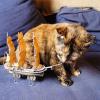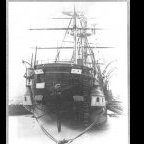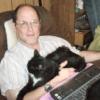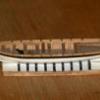HOLIDAY DONATION DRIVE - SUPPORT MSW - DO YOUR PART TO KEEP THIS GREAT FORUM GOING!
×
-
Posts
3,479 -
Joined
-
Last visited
Reputation Activity
-
 Cathead got a reaction from cazzie49 in HMS Beagle by brunnels - OcCre - 1:60 - first build
Cathead got a reaction from cazzie49 in HMS Beagle by brunnels - OcCre - 1:60 - first build
Your work looks lovely, but I feel obliged to point out that it's "winch", not "wench". The latter has a very different meaning that makes the above paragraph unintentionally hilarious (especially the deep sea line)!
-
 Cathead got a reaction from Paul Le Wol in Billy 1938 by Keith Black - 1:120 Scale - Homemade Sternwheeler
Cathead got a reaction from Paul Le Wol in Billy 1938 by Keith Black - 1:120 Scale - Homemade Sternwheeler
Pretty sure those are in the photo itself. You can see the wrinkles extending up from the sign, over the bridge pier and bridge.
EDIT: I posted on Page 6 without noting that discussion continued on to Page 7. I agreed with Kurt that it really looks like it's painted over boards, but I haven't done the exhaustive close-up looks Keith has. Are you certain that the tacks you see aren't nailed attaching the boards to inner framing? It would look much the same.
-
 Cathead got a reaction from Glen McGuire in Billy 1938 by Keith Black - 1:120 Scale - Homemade Sternwheeler
Cathead got a reaction from Glen McGuire in Billy 1938 by Keith Black - 1:120 Scale - Homemade Sternwheeler
Pretty sure those are in the photo itself. You can see the wrinkles extending up from the sign, over the bridge pier and bridge.
EDIT: I posted on Page 6 without noting that discussion continued on to Page 7. I agreed with Kurt that it really looks like it's painted over boards, but I haven't done the exhaustive close-up looks Keith has. Are you certain that the tacks you see aren't nailed attaching the boards to inner framing? It would look much the same.
-
 Cathead got a reaction from Ryland Craze in Billy 1938 by Keith Black - 1:120 Scale - Homemade Sternwheeler
Cathead got a reaction from Ryland Craze in Billy 1938 by Keith Black - 1:120 Scale - Homemade Sternwheeler
Sorry, Keith, I missed that you'd said that already.
Also, an idea occurs to me. I have a sheet of printed signs left over from the last model railroad building project mentioned on my log. They're on cardstock and quite nice. I could easily slip some of these into an envelope to you if you wanted a few of them for this project. I could see doing some window coverings as plain and a few as signs just to add to the creative quirkiness, since we're none of us sure exactly what he used. Wouldn't cost more than an envelope and a stamp. Here's what the sheet looks like, most of these would be appropriate for the 1930s:
-
 Cathead got a reaction from Keith Black in Billy 1938 by Keith Black - 1:120 Scale - Homemade Sternwheeler
Cathead got a reaction from Keith Black in Billy 1938 by Keith Black - 1:120 Scale - Homemade Sternwheeler
Pretty sure those are in the photo itself. You can see the wrinkles extending up from the sign, over the bridge pier and bridge.
EDIT: I posted on Page 6 without noting that discussion continued on to Page 7. I agreed with Kurt that it really looks like it's painted over boards, but I haven't done the exhaustive close-up looks Keith has. Are you certain that the tacks you see aren't nailed attaching the boards to inner framing? It would look much the same.
-
 Cathead got a reaction from MAGIC's Craig in J H Crawford by LJP (Lawrence Paplham) - Scale 1:64 - an 1894 to 1898 Wisconsin sternwheeler
Cathead got a reaction from MAGIC's Craig in J H Crawford by LJP (Lawrence Paplham) - Scale 1:64 - an 1894 to 1898 Wisconsin sternwheeler
That's what a goat is for. Fresh milk for the pantry, too. I'll stop dragging this off-thread now.
-
 Cathead reacted to Keith Black in Billy 1938 by Keith Black - 1:120 Scale - Homemade Sternwheeler
Cathead reacted to Keith Black in Billy 1938 by Keith Black - 1:120 Scale - Homemade Sternwheeler
Thank you, Tom. It's just not 'there' yet, you know what I mean.
-
 Cathead got a reaction from GrandpaPhil in Billy 1938 by Keith Black - 1:120 Scale - Homemade Sternwheeler
Cathead got a reaction from GrandpaPhil in Billy 1938 by Keith Black - 1:120 Scale - Homemade Sternwheeler
Sorry, Keith, I missed that you'd said that already.
Also, an idea occurs to me. I have a sheet of printed signs left over from the last model railroad building project mentioned on my log. They're on cardstock and quite nice. I could easily slip some of these into an envelope to you if you wanted a few of them for this project. I could see doing some window coverings as plain and a few as signs just to add to the creative quirkiness, since we're none of us sure exactly what he used. Wouldn't cost more than an envelope and a stamp. Here's what the sheet looks like, most of these would be appropriate for the 1930s:
-
 Cathead got a reaction from Keith Black in J H Crawford by LJP (Lawrence Paplham) - Scale 1:64 - an 1894 to 1898 Wisconsin sternwheeler
Cathead got a reaction from Keith Black in J H Crawford by LJP (Lawrence Paplham) - Scale 1:64 - an 1894 to 1898 Wisconsin sternwheeler
That's what a goat is for. Fresh milk for the pantry, too. I'll stop dragging this off-thread now.
-
 Cathead got a reaction from tmj in J H Crawford by LJP (Lawrence Paplham) - Scale 1:64 - an 1894 to 1898 Wisconsin sternwheeler
Cathead got a reaction from tmj in J H Crawford by LJP (Lawrence Paplham) - Scale 1:64 - an 1894 to 1898 Wisconsin sternwheeler
That's what a goat is for. Fresh milk for the pantry, too. I'll stop dragging this off-thread now.
-
 Cathead got a reaction from LJP in J H Crawford by LJP (Lawrence Paplham) - Scale 1:64 - an 1894 to 1898 Wisconsin sternwheeler
Cathead got a reaction from LJP in J H Crawford by LJP (Lawrence Paplham) - Scale 1:64 - an 1894 to 1898 Wisconsin sternwheeler
That's what a goat is for. Fresh milk for the pantry, too. I'll stop dragging this off-thread now.
-
 Cathead reacted to Keith Black in Billy 1938 by Keith Black - 1:120 Scale - Homemade Sternwheeler
Cathead reacted to Keith Black in Billy 1938 by Keith Black - 1:120 Scale - Homemade Sternwheeler
The name board height has been corrected. I tried doing the lettering freehand, I've gotten close but not there yet.
Keith
-
 Cathead reacted to LJP in J H Crawford by LJP (Lawrence Paplham) - Scale 1:64 - an 1894 to 1898 Wisconsin sternwheeler
Cathead reacted to LJP in J H Crawford by LJP (Lawrence Paplham) - Scale 1:64 - an 1894 to 1898 Wisconsin sternwheeler
Cathead,
No, JHC stayed with the Astroturf. Real grass would have required a faucet in the stateroom to water the grass, a lawnmower to cut the grass, and a horticulturist to maintain the grass. Way too expensive on a working boat.
🤣
LJP
-
 Cathead got a reaction from Keith Black in J H Crawford by LJP (Lawrence Paplham) - Scale 1:64 - an 1894 to 1898 Wisconsin sternwheeler
Cathead got a reaction from Keith Black in J H Crawford by LJP (Lawrence Paplham) - Scale 1:64 - an 1894 to 1898 Wisconsin sternwheeler
So does the steward install temporary real turf when a VIP books a room?
-
 Cathead reacted to LJP in J H Crawford by LJP (Lawrence Paplham) - Scale 1:64 - an 1894 to 1898 Wisconsin sternwheeler
Cathead reacted to LJP in J H Crawford by LJP (Lawrence Paplham) - Scale 1:64 - an 1894 to 1898 Wisconsin sternwheeler
Cathead,
TOO FUNNY! So I suppose the blue employee bunks on the main deck are Boise State Blue Astroturf?
LJP
-
 Cathead got a reaction from thibaultron in Billy 1938 by Keith Black - 1:120 Scale - Homemade Sternwheeler
Cathead got a reaction from thibaultron in Billy 1938 by Keith Black - 1:120 Scale - Homemade Sternwheeler
Sorry, Keith, I missed that you'd said that already.
Also, an idea occurs to me. I have a sheet of printed signs left over from the last model railroad building project mentioned on my log. They're on cardstock and quite nice. I could easily slip some of these into an envelope to you if you wanted a few of them for this project. I could see doing some window coverings as plain and a few as signs just to add to the creative quirkiness, since we're none of us sure exactly what he used. Wouldn't cost more than an envelope and a stamp. Here's what the sheet looks like, most of these would be appropriate for the 1930s:
-
 Cathead got a reaction from thibaultron in Billy 1938 by Keith Black - 1:120 Scale - Homemade Sternwheeler
Cathead got a reaction from thibaultron in Billy 1938 by Keith Black - 1:120 Scale - Homemade Sternwheeler
Honestly I don't see anything that looks like signs. The patterning looks like anything from curtains to plywood to cardboard, with arguably the distorting effect of refraction in glass in a blurry image.
As for lettering the stern, have you considered dry transfer letters? They're straightforward to use, though require careful alignment as you have to do each one separately. But you're no stranger to careful small-scale work. Most come in sheets of all letters, which can be annoying, but in your case that means you have lots of spare letters to experiment with before using your precious B-I-L-L-Y. Woodland Scenics makes a wide variety of different fonts. Same things I used to letter the storefronts in my railroad build.
-
 Cathead got a reaction from thibaultron in Billy 1938 by Keith Black - 1:120 Scale - Homemade Sternwheeler
Cathead got a reaction from thibaultron in Billy 1938 by Keith Black - 1:120 Scale - Homemade Sternwheeler
Keith, on the houseboat/barge, aren't those windows?
-
 Cathead got a reaction from Old Collingwood in Missouri, Kansas, & Texas Railroad along the Missouri River by Cathead - 1/87 (HO) scale - model railroad with steamboat
Cathead got a reaction from Old Collingwood in Missouri, Kansas, & Texas Railroad along the Missouri River by Cathead - 1/87 (HO) scale - model railroad with steamboat
I'm a member and have every intention of doing so! The one in St. Louis two years ago was great. Last year's was in Texas and I had a family conflict with traveling that far. KRHS site definitely has some nice resources, though most are a bit too modern for my era. The State Historical Society of Missouri has quite a bit of useful material both online and in their physical research center, which isn't that far from me.
And non-masters like me as well!
-
 Cathead got a reaction from Old Collingwood in Missouri, Kansas, & Texas Railroad along the Missouri River by Cathead - 1/87 (HO) scale - model railroad with steamboat
Cathead got a reaction from Old Collingwood in Missouri, Kansas, & Texas Railroad along the Missouri River by Cathead - 1/87 (HO) scale - model railroad with steamboat
Ken, I find that the story-telling aspect of model railroading is very appealing to the historian and writer in me. Obviously every model can tell a story, but there's something particularly rich in designing and implementing an entire setting, beyond just a stand-alone item. I'm really enjoying how this town is coming together and I look forward to expanding the layout, probably early next year.
And thanks to Keith and all the other supporters!
-
 Cathead got a reaction from Old Collingwood in Missouri, Kansas, & Texas Railroad along the Missouri River by Cathead - 1/87 (HO) scale - model railroad with steamboat
Cathead got a reaction from Old Collingwood in Missouri, Kansas, & Texas Railroad along the Missouri River by Cathead - 1/87 (HO) scale - model railroad with steamboat
Another building for you. This is the other "wrong side of the tracks" structure, where the land starts sloping down toward the river and incomes and property values are lower. Intended as a general tavern / store kind of place. You can see the kit's version here: https://www.blairline.com/samsroadhouse/ No photos of construction, because it's a pretty straightforward laser-cut kit and I didn't do anything particularly unique to it. Just some basic weathering.
I didn't use the kit's corrugated metal roofing (see link above), preferring tar paper. Although metal roofing was in use by 1900, my sense is it was far from ubiquitous. I don't have any other buildings I intended to use metal roofing on, and it'd look strange for the only building with such a new-fangled idea to be one of the rougher settings. I also didn't want a super-rusty look as even in the rougher part of town, I want Rocheport to have a well-kept appearance, and I wanted this to look like a relatively recent construction, not a 50-year-old wreck.
Notice the outhouse downhill in the back, that was part of the kit. Also part of the kit was a sheet of possible signs. I chose a couple brands that really were produced in St. Louis during this era, Falstaff beer and Star tobacco. The manufacturer's version has this building plastered with signs, but I think that's overkill clutter and like how just a few add some flair while letting the building breathe overall.
I intentionally chose this one and its partner across the street because they're up on posts, as is common for river-adjacent structures in this region. I used small pieces of crushed limestone to build up support pillars for the wooden posts. This is also pretty common around here in older buildings. Close eyes will notice in the first photo that I need to stick a couple rocks under the front porch posts. I like how this sticks out over the slope that starts descending down to the river.
No paint on this one, it's all pastel weathering. I really wanted this to have a raw-wood look to it. The lower supports are intentionally more reddish to hint that maybe they were built from local Eastern Red Cedar, which is highly rot resistant and very common around here. I've built all of my full-scale outbuildings from it, and it would have been quite easy for someone to harvest in 1900, too. I think the raw wood goes well with the subtle grey of the sharecropper house, and contrasts with the brighter colors of the depot area.
And here's a broader view, showing how this frames the street leading from the river landing into town past the east side of the depot. That's the last building for this district; other than trees, other vegetation, and some fencing, that's pretty much how this is intended to look.
Thanks for following along!
-
 Cathead got a reaction from Geordie Tyne in Billy 1938 by Keith Black - 1:120 Scale - Homemade Sternwheeler
Cathead got a reaction from Geordie Tyne in Billy 1938 by Keith Black - 1:120 Scale - Homemade Sternwheeler
Sorry, Keith, I missed that you'd said that already.
Also, an idea occurs to me. I have a sheet of printed signs left over from the last model railroad building project mentioned on my log. They're on cardstock and quite nice. I could easily slip some of these into an envelope to you if you wanted a few of them for this project. I could see doing some window coverings as plain and a few as signs just to add to the creative quirkiness, since we're none of us sure exactly what he used. Wouldn't cost more than an envelope and a stamp. Here's what the sheet looks like, most of these would be appropriate for the 1930s:
-
 Cathead got a reaction from Geordie Tyne in Billy 1938 by Keith Black - 1:120 Scale - Homemade Sternwheeler
Cathead got a reaction from Geordie Tyne in Billy 1938 by Keith Black - 1:120 Scale - Homemade Sternwheeler
Honestly I don't see anything that looks like signs. The patterning looks like anything from curtains to plywood to cardboard, with arguably the distorting effect of refraction in glass in a blurry image.
As for lettering the stern, have you considered dry transfer letters? They're straightforward to use, though require careful alignment as you have to do each one separately. But you're no stranger to careful small-scale work. Most come in sheets of all letters, which can be annoying, but in your case that means you have lots of spare letters to experiment with before using your precious B-I-L-L-Y. Woodland Scenics makes a wide variety of different fonts. Same things I used to letter the storefronts in my railroad build.
-
 Cathead got a reaction from Keith Black in J H Crawford by LJP (Lawrence Paplham) - Scale 1:64 - an 1894 to 1898 Wisconsin sternwheeler
Cathead got a reaction from Keith Black in J H Crawford by LJP (Lawrence Paplham) - Scale 1:64 - an 1894 to 1898 Wisconsin sternwheeler
Looks amazing! Though I have to admit, the Astroturf bed made me laugh.
-
 Cathead reacted to wefalck in Gjoa 1872 by Jond - 1:48 scale - Amundson's Cutter
Cathead reacted to wefalck in Gjoa 1872 by Jond - 1:48 scale - Amundson's Cutter
Well, this slot under the lowest bulwark-plank seems to have common feature on smaller vessels all around the Baltic and Scandinavia, particularly, when the water-way was more or less flush with the deck. I have seen many original vessels and models like this.
Another option would have been hinged freeing ports that were locked in fine weather with a latch. The freeing ports are essentially the lowest bulwark-plank divided into sections that are individually hinged. I will discuss this particular feature in the forthcoming post on my building-log for a Rahschlup.
In the 1870s seaboots commonly would not have been rubber although such boots seem to have been manufactured since the middle of the century. They were oiled leather, above knee-length and had either wooden or heavy leather soles with hob-nails. In the Arctic, rubber-boots would have been impractical, as the rubber becomes stiff and brittle, prone to cracking and also conducts heat much better than leather - cold feet guaranteed in spite of heavy woolen socks.










